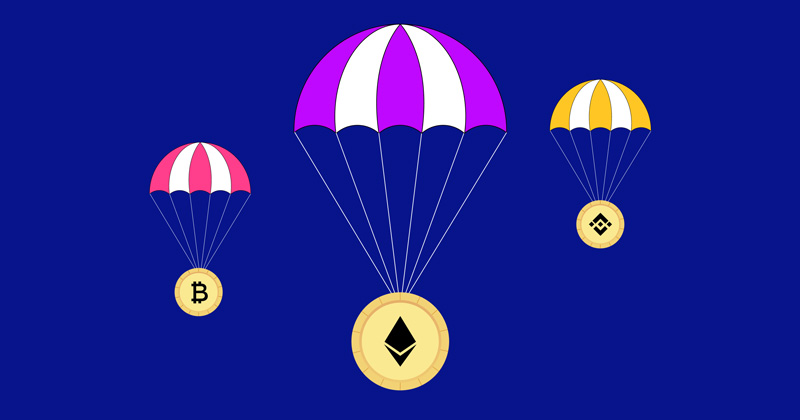
Unitribune reports:
Airdrops are one of the most popular ways to earn free cryptocurrency. In this method, crypto projects distribute their tokens for free to users to grow their community and promote the project. In this article, we’ll answer the question: What is an Airdrop? and explore its details. We’ll also discuss the goals, types, advantages, and risks associated with airdrops.
What Is an Airdrop and How Does It Work?
In cryptocurrency, an airdrop is the process of distributing free or semi-free tokens of a project to users. The goal is usually to raise awareness, attract new users, or reward existing members of the ecosystem. Airdrops are one of the most common marketing strategies for new crypto projects and play a crucial role in introducing tokens to the public.

During an airdrop, a portion of the project’s tokens is sent directly to users’ digital wallets without the need to buy or trade them. Airdrops serve as a marketing tool to attract new users and increase awareness about a project. Understanding airdrops can help users maximize their potential gains in the crypto market.
Main Goals of Airdrops in Crypto
Airdrops are not just about giving free tokens—they are a strategic tool for marketing and network growth. Projects typically conduct airdrops with the following objectives:
Attracting New Users
Airdrops are one of the fastest ways to grow a user community. For example, the Starknet project saw over 1.2 million new active wallets after its February 2024 airdrop.Fair Token Distribution
If tokens are held only by large investors, network centralization occurs. Airdrops help distribute tokens more evenly. Arbitrum’s (ARB) 2023 airdrop distributed over 60% of initial tokens to small users.Enhancing Decentralized Governance
DeFi projects often give tokens to early users to participate in governance. Uniswap (UNI) saw over 40,000 users vote in its first governance process following its 2020 airdrop.Viral Marketing and Social Media Buzz
Airdrops attract media and social attention. After dYdX’s airdrop, its official Twitter gained over 150,000 new followers in just two weeks.
Types of Cryptocurrency Airdrops
Understanding different types of airdrops can help users choose the right opportunities:
Standard Airdrops
Airdrop Hunting
Holder Airdrops
Exclusive Airdrops
Raffle Airdrops
Hard Fork Airdrops
Standard Airdrops
Users receive tokens without performing complex tasks. For example, Starknet’s February 2024 airdrop distributed STRK tokens to users who had previously used DApps on its network. Rewards ranged from $200 to $2,000 per user.

Airdrop Hunting
Requires users to perform simple promotional tasks:
Follow project accounts on social media
Retweet and like posts
Join Telegram or Discord channels
Refer friends via invite codes
Projects like zkSync, LayerZero, Scroll, and Manta Network rewarded early, active users with valuable tokens.
Holder Airdrops
Tokens are distributed to users who already hold certain cryptocurrencies. For instance, Flare Network distributed SPARK tokens to XRP holders based on their holdings at a specific date.
Exclusive Airdrops
Reward early participants or those contributing to the project in non-token ways. Uniswap distributed 400 UNI tokens per eligible user in 2020 regardless of trading volume.
Raffle Airdrops
Used when there’s high user interest, winners are randomly selected from participants. Projects like Galxe and Sweatcoin have used this method.
Hard Fork Airdrops
When a blockchain splits, holders of the original token receive tokens of the new chain. Ethereum’s 2016 DAO fork resulted in ETH and ETC tokens being distributed proportionally.
Advantages and Risks of Airdrops
| Advantages | Risks |
|---|---|
| Free tokens | Tokens may have low value |
| Discover new projects | Risk of scams |
| Encourages ecosystem participation | Time-consuming tasks |
| Potential long-term gains | Delays or lack of distribution |
| Often no initial investment | Risk of phishing |
| Builds user loyalty | Taxes in some countries |
Reducing Airdrop Risks
Use a separate wallet for airdrops
Rely on official sources
Avoid signing suspicious transactions
Consider gas fees vs. potential gains
History of Airdrops
The first airdrop occurred in 2014 with Auroracoin, which distributed half of its tokens to Icelandic citizens using their national IDs. From 2017 to 2021, airdrops became a popular marketing tool, with projects like OmiseGO, Stellar, and Ontology rewarding early adopters and building communities.
Participation Considerations for Iranian Users
Some international projects restrict access due to:
International sanctions
Mandatory KYC
Risk of wallet blocking
Low-risk strategies include using decentralized projects without KYC, checking project terms, testing in testnets, and using non-custodial wallets like MetaMask, Rabby, or Tonkeeper.

Can You Make Money with Airdrops?
Airdrops may seem like free money, but only 10–15% provide significant returns. Many tokens lose value or are hard to sell. Examples include:
Profitable: Uniswap (UNI) 2020, 400 tokens worth over $12,000 at peak
Average: Starknet (STRK) 2024, ~$500 per user
Low-value: Many small projects, tokens under $10
Top Tools and Resources for Airdrops
DeBank: Multi-chain portfolio tracking
Dune Analytics: Visual dashboards for transactions
Guild.xyz: Connect wallets for Discord/Telegram
Layer3 & Zealy (Crew3): Social mission platforms
Snapshot.org: DAO voting participation
Nansen: Whale tracking
Airdrop Alert: Reliable airdrop listings
Step-by-Step Guide to Participate in Airdrops
Find a reliable airdrop via official sources
Read the requirements carefully
Complete the tasks (social, DApp interactions)
Connect your wallet safely
Fill out any required forms
Claim your tokens
Most Successful Airdrops in Crypto History
Uniswap (UNI) 2020
Value per token: ~$1.5 initially
Peak market value: $40+
Average user profit: $1,500–16,000
Even users who interacted with Uniswap only once were eligible for rewards, showing the immense potential of early participation.







